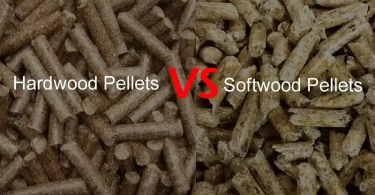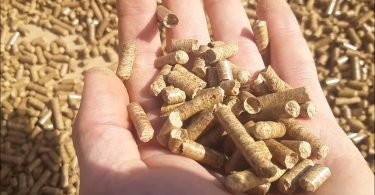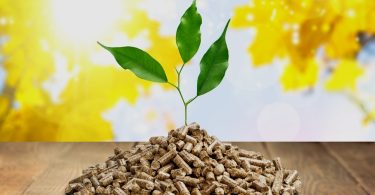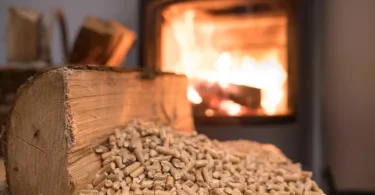Fuel pellets are a versatile energy source that can be used in multiple industries and for multiple applications. They can be used in the residential and industrial sector, for a variety of purposes, and they can be made from a variety of materials. Depending on the feedstock that is used in their making, the production process can be a little bit different. Let’s go and check how wood fuel pellets are made.
Fuel Pellets
Fuel pellets come in the shape of small cylinders that are between 5-10 millimeters in diameter and some 2-4 centimeters long. They pack a lot of energy, so an average mix of pellets will store around 4.85 kWh of energy per kilo. This makes them a great energy source for heating and energy generation.
Based on their intended use, pellets can be divided into those for residential and industrial application. Residential application means that the pellets are used in cooking stoves, in grills and smokers and for home or residential hot water heating. Industrial application means that the heat that they release is used to help or accommodate different chemical reactions in diverse production processes or to generate power in large factories or similar establishments.
They’re also incredibly easy to handle and store, thanks to their uniform size and packaging. But the question of how they’re made is still unanswered. Let’s go and let’s consider the whole process in more detail.
How Are Pellets Made?
Wood Pellets can be made from a variety of materials. They can be made from wood, different types of waste, including paper, and even agricultural residue or agricultural waste. Based on the materials that are used as the feedstock, the production process consists of more or less six steps.
The initial step is obviously securing the feedstock and the quality of the materials to be used. Not just any organic material can be used to make pellets. Organic material used has to have a certain moisture content, so these organic materials often have to be dried before they are processed. Pelletting or extrusion is the next logical step. As pellets leave the extruder they are very hot and soft to the touch so they have to be cooled down for efficient storing and packaging.
* Feedstock Preparation
Feedstock preparation is an essential step as without the feedstock there is no final product. Wood fuel pellets demand high quality wooden fibrous materials that contain no plastics or metals. The presence of plastics in the feedstock can compromise the final product, while metal particles such as nails and screws can cause damage to the equipment used to make pellets. For this reason all the feedstock is sieved and strong magnets are used to pull out any metal parts.
It is during this stage in the production that materials are sorted into virgin wood, untreated wood and treated wood. If biomass is used, it is during this feedstock preparation phase the different mixes of biomass are made for later pelletization. For example, grass pellet combustion produces a lot of ash and some smoke. But, introducing 20% of woody materials to 80% of grass clippings resolves this issue and results in pellets of higher quality.
On top of this, this is a stage where most experimentation starts. In Italy, for example, coffee grounds are a biomass material that is oftentimes experimented with. Some experiments have found that introducing 25% of coffee grounds into the pellet mix results in pellets of higher energy density that store upwards of 5 kWh of energy per kilo, which is some 10 to 20% higher than regular pellets made of wood.
Needless to say, the feedstock is also sorted by size. This is done because the material entering the extruder has to be of sawdust like consistency. Special grinders, choppers and hammer mills are used to ensure uniform particle size. At the end of this process, the moisture levels are read.
* Drying
If the material is too moist, it has to be dried. This is done outside, in the sun or in special dryers which use the waste from the pellet production process to heat the air and accommodate the drying process. The pellet material can’t be too dry. The sweet spot for making the pellet is between 12-18% moisture.
If the material is too wet, it can clog up the machines and compromise both the equipment and the entire manufacturing process. On the other hand, if the material is too dry, it won’t pelletize well and you could end up with a product that easily crumbles and is not of uniform size. For this reason, reading the moisture levels several times during the production process is a must.
* Pelleting
The pelleting itself is done in special machines which are called pelletizers or pelletiers or extruders. These extruders contain die with a number of holes in it. Each hole continues into a small tunnel that is of the diameter that the pellets to be made need to be. In most cases, these tunnels have a diameter of 6 or 8 millimeters, although different sizes are available.
As the feedstock enters the extruder, strong rollers apply a lot of pressure onto this biomass. The organic materials are pushed through the tunnel. The pressure that is applied to them compresses them to around 25% of their original volume. This pressure, accompanied by friction, generates a lot of heat, somewhere around 90 degrees Celsius.
As the newly formed pellets exit the tunnels they are cut to a predetermined size by special rotating knives. Then, they fall onto the conveyor belt or in a storage tank and are taken to the cooling phase. The cooling phase happens either on a conveyor belt or in special cylindrical storage units, where strong fans push the air through the pellets, cooling them down and solidifying them in the process.
* Cooling
The cooling process is an absolute must. As pellets exit the extruder, they’re very hot, moist and soft. This is exactly the opposite of what pellets need to be like. The moisture that can be felt around them is quickly evaporated during the cooling phase, as the air current takes the water vapor away from the pellets.
This results in a product that can release more heat into the space to be heated, rather than using that same heat to evaporate the high water content and push this heavy exhaust through the chimney. The ideal moisture content is somewhere between 5-10%. This also yields a long-lasting product.
The cooling stage also helps solidify the pellets. During the formation phase, as they heat up, a lot of lignin is released from the woody portion of the feedstock mix. This lignin acts as a natural glue, so that no natural or synthetic glues need to be introduced into the production process. This results in a green and sustainable product that is hard to the touch and does not break easily.
* Storing
The final product in the form of hard pellets can then be stored in bulk or pre-packed. For as long as they’re kept in a cool and dry area, pellets can last for years, both in the warehouse of the production facility and in your home. Pellets are very easy to store and transport. This is one of the reasons why they are so successful as a fuel source. Storing is an optional phase in the production process, and most plants producing wood pellets pack them straight away.
* Packaging
The packaging phase of the pellet fuel production is the last step. Pellets are packed in bags that are between 15-18 kilos heavy. This makes them easy to stack on pallets and it also enables very easy handling once they are in your home. They are light enough to lift easily, but still carry enough pellets that most homes need no more than one to two bags per day.
Bulk packing is done in special bags that can hold anywhere between 1-1.2 metric tons of pellets at a time. These bags are mostly used in industrial applications or when it is necessary to heat an entire residential building. For larger applications, entire truckloads of pellets can be sent to your desired destination. These places need to have appropriate space for storing pellets. The space needs to be protected from humidity, critters and other pests that would compromise the quality of the pellets or introduce humidity in the environment.
Pellet Material Sourcing
When it comes to sourcing the material used as feedstock for pellet making. It is important to always purchase pellets that are made from sustainable materials. These materials can include agricultural residue, waste from different Industries, including wood processing industry and paper processing industry, as well as recycling industries.
If we are talking about wood, it needs to come either as a waste from another industry or from responsibly managed forests. This ensures that the product that is advertised as green or sustainable indeed is as good for nature as the labels make it seem.
The Economic Aspect of Pellet Making
Pellets are very economically viable. A single ton of pellet can provide as much heat and energy as around three metric tons of wood fuel. On top of this, they are a good substitute for heating oil, natural gas, and other forms of heat fuel. The energy consumption of pellet stoves used in residential settings is very low, so they are very energy efficient and you will get a lot of heat with very small energy input. Pellets for personal use and pellets for selling are both great products that can be sold at low prices and still provide reasonable margins.
* Energy Consumption
As pellet stoves need power supply to operate, the logical question of how much power they consume can be asked. This question is very easy to answer: an average wood pellet stove for residential use uses around 100 Watts of power. This is comparable to a single incandescent light bulb.
On the other end of the spectrum, the energy that is needed to produce these pellets is also very low. Extruders that can produce hundreds of kilos of pellets per hour, oftentimes use no more than 5 kilowatts of energy. In addition to this, if you are thinking about producing pellets as a business model, you should also consider that it takes around 1% of energy stored in pellets to transport them up to 250 kilometers by land or 2500 kilometers by sea routes. This makes them very easy and cheap to transport.
* Pellets for Personal Use
Pellets for personal use or residential use need to be a certain quality. If you are thinking about making your own pellet or purchasing some, you should always look for certain sustainability labels that are applicable in your country. In addition to this, if you’re about to use pellets for cooking such as in cooking pellet stove, grills, or smokers you should also consider the feedstock materials that were used.
Virgin wood, and untreated waste wood are oftentimes the best possible choices. If you are looking to purchase pellets that are made out of biomass or agricultural waste, it is also useful to consider the type of pellet stove that you have, as different types of stoves accommodate for different types of pellets. Burning inappropriate kind, or the inappropriate size, of pellets can cause some issues and make your equipment malfunction. With this in mind, always be aware of the product that you are buying.
* Pellets for Selling
If you have a pellet making business or are about to start one you should know that pellets for selling are a good idea in most parts of the world. Although not every single country has yet adopted this kind of technology, the technology has been on the rise throughout the world. Europe, for example, sees a 5% annual increase in the use of pellets.
As they are sustainable and green and as they produce very little pollutants including carbon monoxide, PM particles, methane, and smoke, they’re a very attractive fuel source for almost every household. As the equipment to make wood pellets can be quite expensive, it may be useful to start small and build up as you make your first income.
Final Considerations
Switching from wood, natural gas, coal, or heating oil to pellets is a reasonable decision. Pellets are a very advanced product, pack a lot of heating energy, and have a variety of uses that make them a very attractive heat fuel. The production process, as outlined above, is the basic process of making fuel pellets. Using the different types of feedstock can call for some changes in the manufacturing process, but the basics are as outlined.








